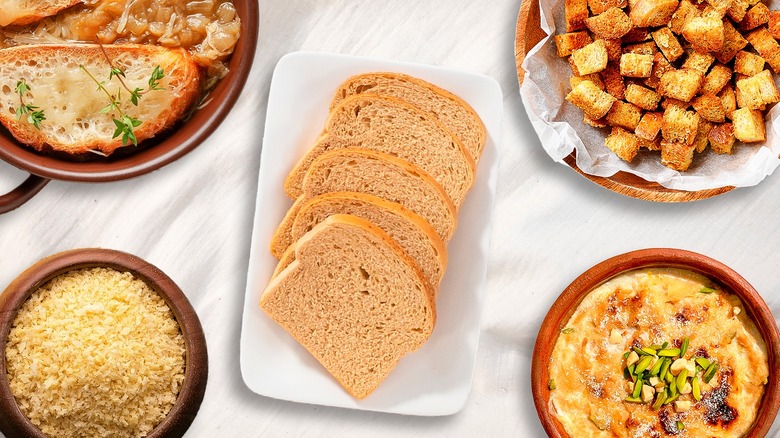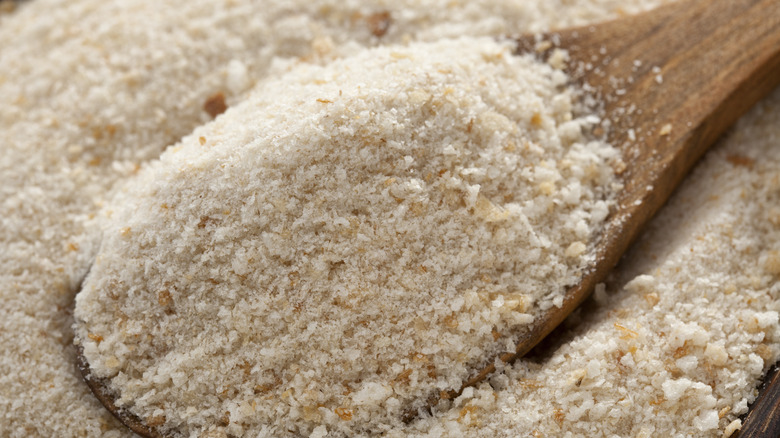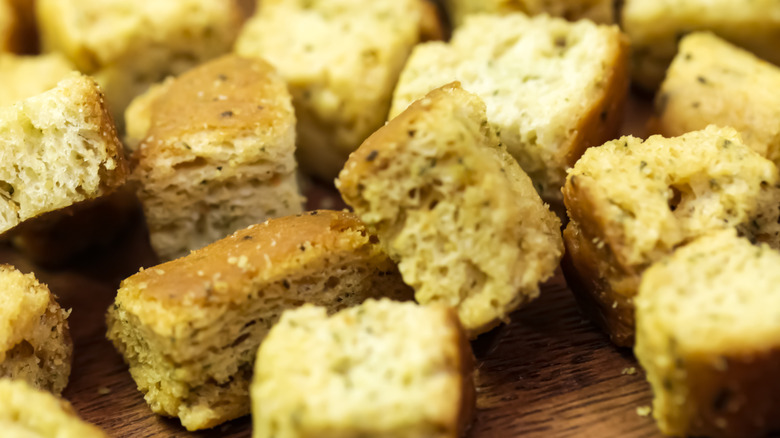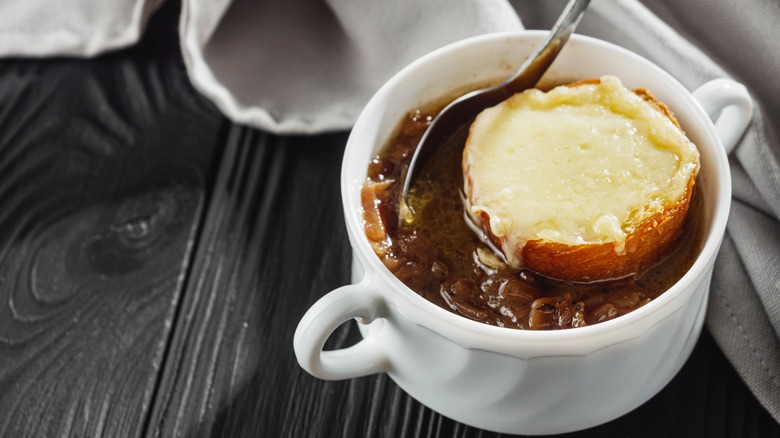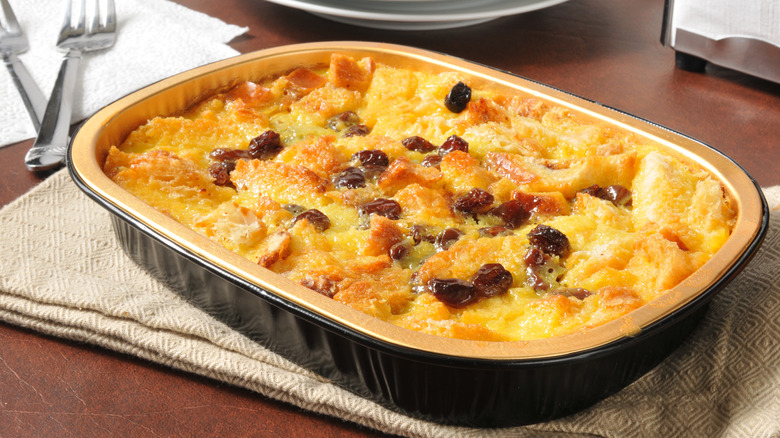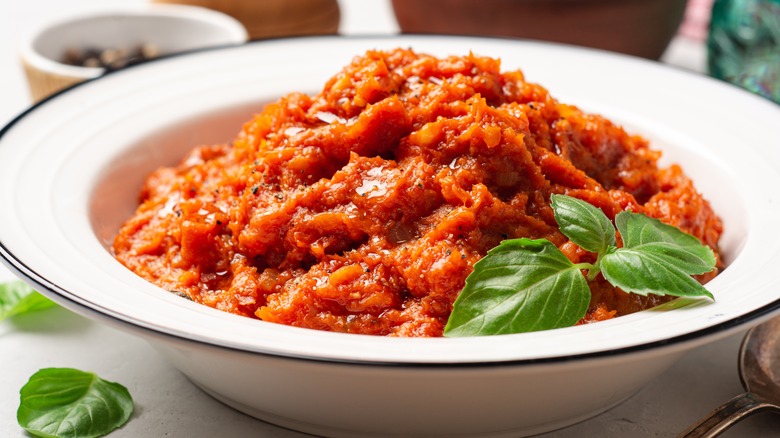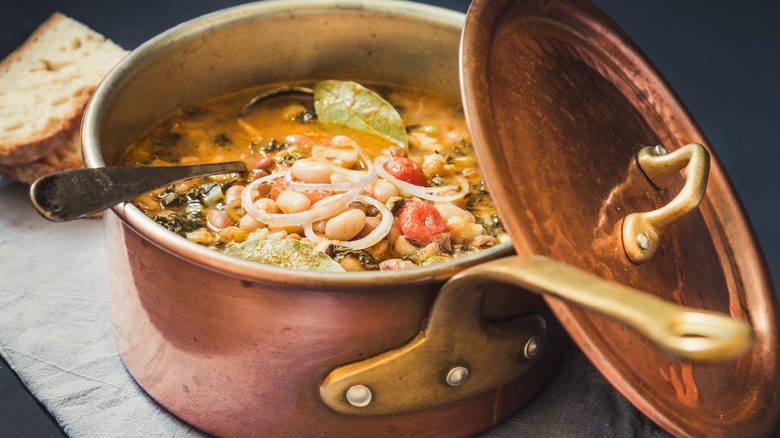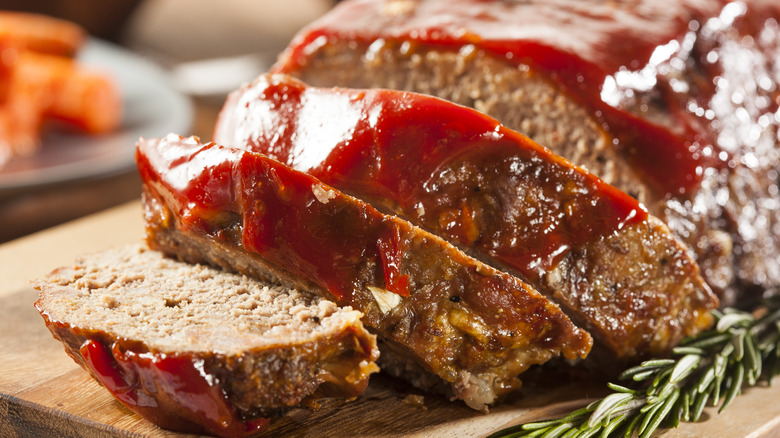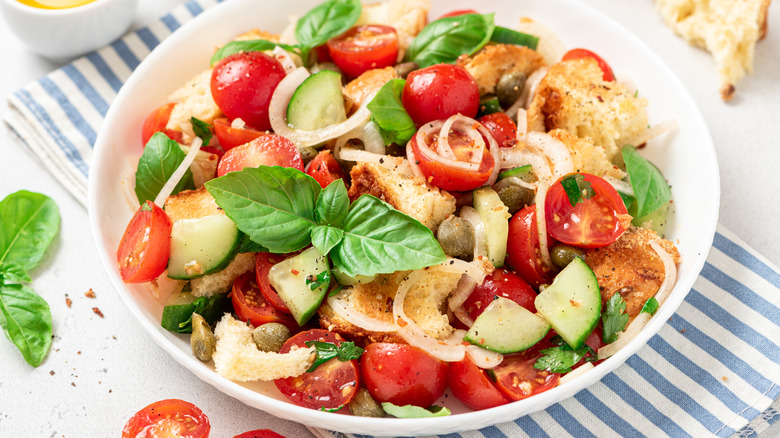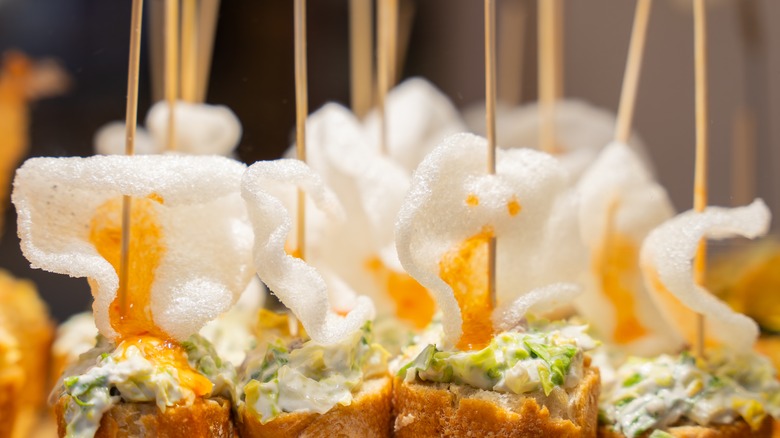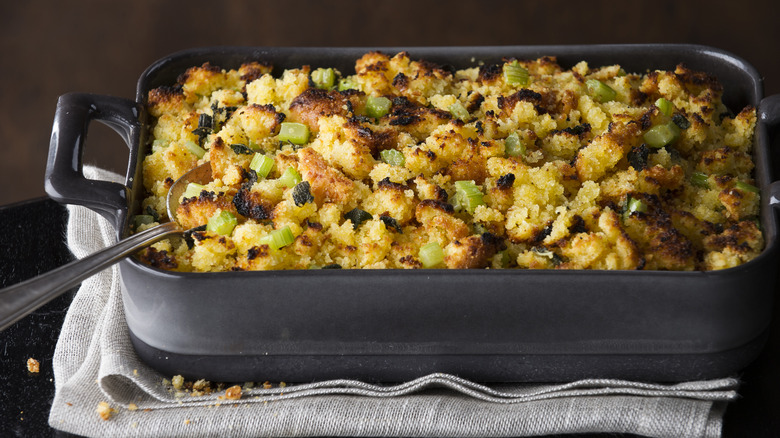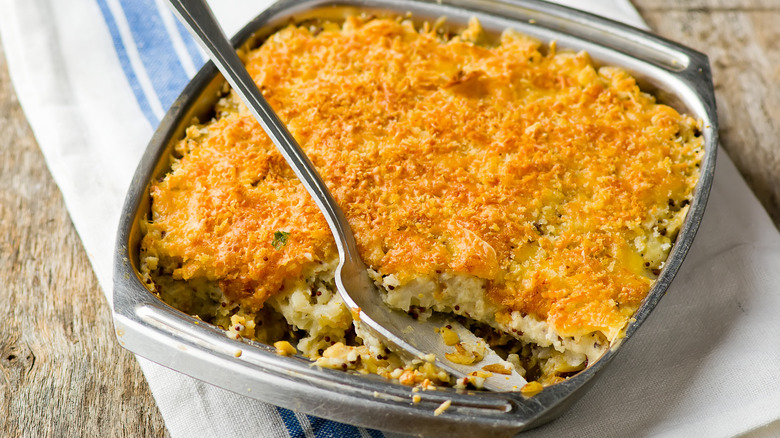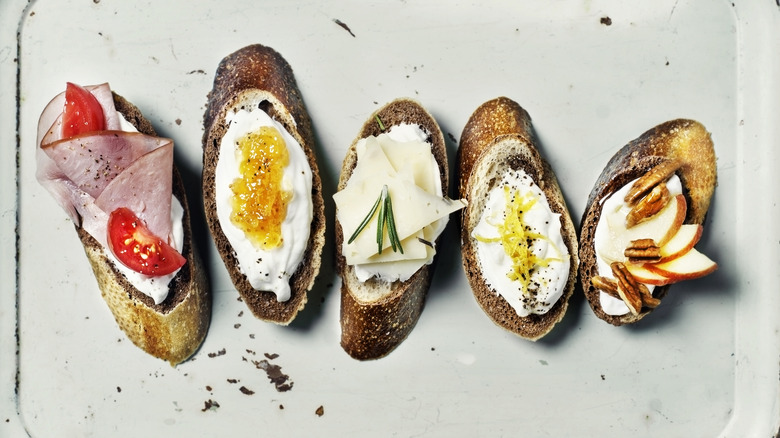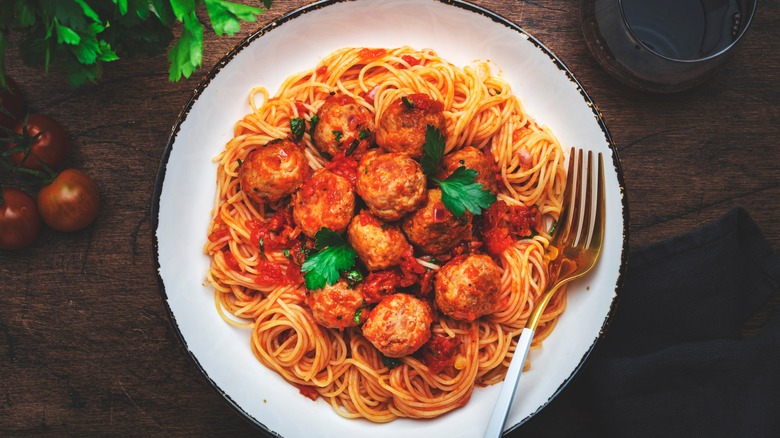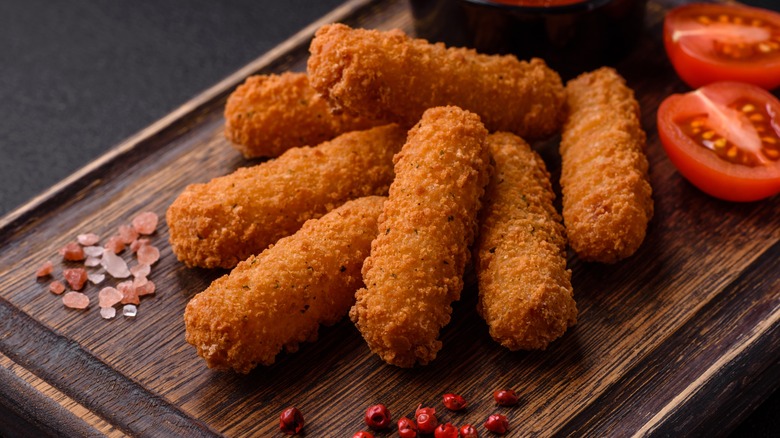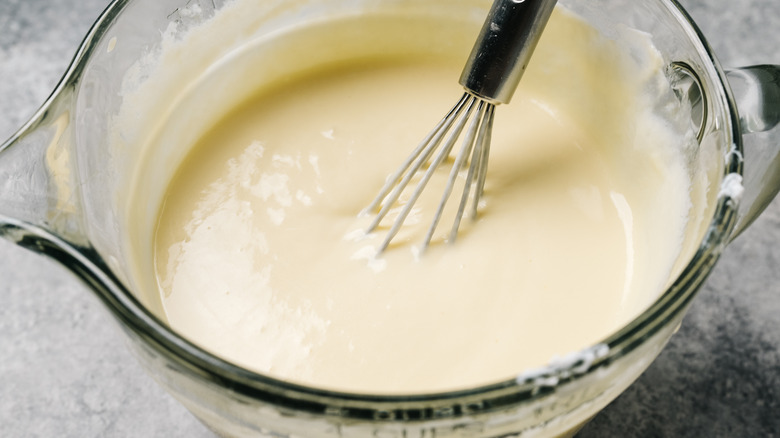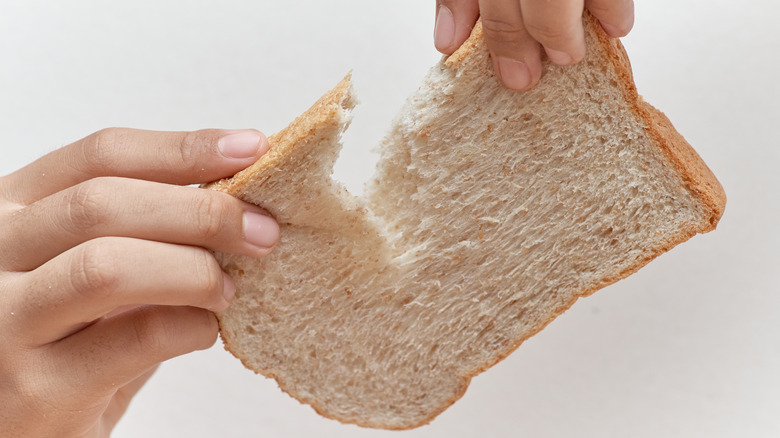16 Clever Ways To Use Stale Bread
It's happened to the best of us – you reach for a piece of that delicious, crusty baguette you bought yesterday or a loaf of sliced bread, and you realize it's gone stale. Stale bread may still be fairly moist, but it doesn't taste as soft and flavorful as it once did. Eventually, it will become too hard to eat without some serious effort, especially if it's a variety like traditional baguette. Bread might seem useless without its flavor and fresh texture, but that's not the case. You should never eat bread if it's moldy, but if it's stale, it's still salvageable – it can even be used to make some delicious dishes.
Stale bread has been a problem — with, often, a tasty solution — for ages. This is especially true in cultures where bread is frequently part of a meal. You'll find lots of recipes using stale bread in French and Italian cuisine, for instance. Believe it or not, though, stale bread can do even more than help you create a delectable main course or appetizer. Not only can you make some yummy desserts with stale bread, but it can also help you with household tasks, like picking up glass and removing smudges from your walls. As the main cook in my Paris-based Franco-Italian-American household where leftover bread is a fact of life, here are some of my favorite ways to use stale bread.
Breadcrumbs
You can use most kinds of bread that come in loaf or baguette form for breadcrumbs. Whatever the type, stale bread is easiest to work with when it needs to be as hard as possible while still fairly easy to cut. The simplest way to make breadcrumbs with stale bread is by cutting or breaking it into small cubes. Fill your food processor a little less than halfway with them, then reduce the cubes to crumbs. Empty the container and then repeat the steps with another batch. When all of the bread is crumbled, lay it on a cooking sheet and bake the crumbs for about 10 minutes at 350 F, stirring after about 5 minutes.
Although this is the easiest way to make breadcrumbs, there are other methods. For instance, you can use a grater if you don't have a food processor or your bread is too hard to break into cubes. However you've transformed your stale bread, you can mix in dry seasonings with your breadcrumbs or leave them plain. Opinions vary on how long homemade breadcrumbs last. Most cooks agree that they're acceptable for a few days in a sealed container on your countertop. After that, they should be refrigerated or frozen. Homemade breadcrumbs can last about a week in the fridge, maybe more. When frozen, they can last for several months.
Croutons
Nothing is more frustrating than discovering that the crusty baguette you bought just a day or two ago is now a hard lump. However, the saying should go, "When life gives you a hard baguette, make croutons!" You can use just about any kind of stale bread to make croutons, and the way to do it may sound familiar after learning how to make breadcrumbs. Cut stale bread into cubes — the same size as store-bought croutons. Some people like to freestyle it and just tear the bread into chunks of about this size, and that's fine, too.
Whichever you choose to do, the next step is to season your breadcrumbs-in-the-making. My favorite is a simple combo of garlic powder and salt, but you can use just about any herbs or spices you'd like. There is one key ingredient you'll need, though: olive oil or butter. Mix the butter or oil and seasonings together in a big bowl, and then add the bread squares (or pieces). Mix it together so that they're coated in the oil or butter and seasoning mixture. Then, pop them into the oven for about 15 minutes, and voila! You'll have delicious, homemade croutons. Store them in a sealed container if you want them to last as long as a week or two. That's plenty of time to enjoy them in salads and soups, or maybe as a little snack on their own.
French onion soup
We often think of French cooking as fancy and complicated, so you may be surprised to learn that French onion soup is traditionally made with stale bread. French onion soup has been around for centuries and has become an iconic part of traditional French weddings, which usually continue into the wee hours. As dawn is approaching and everyone is finally getting hungry after the huge main meal they had that night, French onion soup is usually served to guests.
There are many variants of French onion soup, but the most common way it's made today involves frying onions in butter or oil, and then pouring bouillon (usually beef) onto the caramelized result. Many cooks also include a bit of white wine or other alcohol for extra flavor. The delicious mix is topped off by either croutons or entire pieces of hard or toasted bread, usually with melted cheese on top. The cheese can vary, but gruyère (similar to Swiss) and Comté are the most common choices. The bread you use in this delicious soup can be stale — in fact, that's probably the best option because it needs to be hard. The hot soup and melted cheese will eventually help soften it, but if you prefer to take your hard bread in smaller bites, homemade croutons (another way to use stale bread) are an excellent alternative.
Bread pudding
One of the best-known ways of using stale bread is to make bread pudding, which exists in numerous cultures. Regional and family recipes mean that, in addition to major differences between cultural tastes and available ingredients, there are countless variations on bread pudding. That being said, the recipe you may be familiar with likely features stale bread, custard, sugar, cinnamon and maybe raisins. It dates back to medieval Europe – specifically England – where the dish has been a favorite through the ages.
If you've never made bread pudding, it may seem daunting, since many recipes involve making your own custard. This might be presented as a delicate science, while other recipes — including many by fellow home cooks — take a simpler approach. For instance, while custard technically involves mixing eggs into hot milk or cream and other ingredients, some recipes say to add the eggs and other ingredients to heated milk and butter. You'll also find recipes that rule out custard entirely, replacing it with surprising upgrades like ice cream. Like so many recipes with a long history, bread pudding allows you to be creative. That doesn't just go for the custard; you can also add different dried fruits and go beyond the typical cinnamon seasoning. Even bread pudding's key ingredient can be whatever you want — you can make it with just about any kind of bread. Whether you go the traditional route or something totally original, the results are likely to be delicious.
Pappa al pomodoro
As fun to say as it is delicious, pappa al pomodoro is a traditional Tuscan soup featuring tomatoes and stale bread as its main ingredients. As you might be thinking, this means it's not just a way to use stale bread; it's also a unique and tasty treat that doesn't cost a lot to make. While some recipes will allow canned or pureed tomatoes, the ideal way to make pappa al pomodoro is by using fresh ones, as fresh, quality ingredients are a cornerstone of Italian cuisine.
Whichever you choose, the tomatoes can be left whole, cut, or even pureed. They're then cooked in hot olive oil and garlic (some recipes include onions as well) until they're soft. Then, seasonings — notably basil — are added, along with the stale bread. "Pappa" means "mush" or "baby food" in Italian, so the soup's texture should be soft. This also means you shouldn't use stale bread that's too hard. One thing that is flexible about pappa al pomodoro, on the other hand, is that you can eat it hot, lukewarm, or even cold.
Ribollita
A hearty vegetable soup that includes stale bread as one of its primary ingredients, ribollita is a Tuscan comfort food, especially on cold days. The soup has practical origins: people would add their stale bread to the previous day's vegetable soup, making the mixture hearty and filling. There are many takes on ribollita, but the ingredients you'll find in most traditional recipes include carrots, onions, olive oil, garlic, tomatoes (fresh or canned, depending on the cook), and the stars of the show: cannellini beans and pieces of stale bread.
Typically, you make ribollita by slicing and cooking an onion in olive oil for a minute or two, and then adding the other hard veggies and stirring them in the oil till they've become soft. Next, broth (traditionally vegetable broth), beans, and other soft ingredients are added, as well as the pieces of stale bread. The bread can be fairly hard, or slightly on the soft side, depending on your taste. Ideally, it should be an Italian loaf bread, but you can use what you have or prefer. Some ribollita recipes will also suggest adding sausage slices or grated cheese (my favorite kind is Pecorino Romano, but Parmesan is another popular choice). Traditionalists will probably also call for kale — ideally black kale — but you do you!
Meatloaf
Although versions of meatloaf have been around for millennia, the dish as we know it rose in popularity in the U.S. during the 1930s and '40s. This was when economic hardship and rationing were the norm, since it allowed cooks to stretch limited resources of meat. Since then, meatloaf has remained a popular American classic. Today, there are lots of variants of this loaf-shaped mix of ground meat or meats, chopped veggies, and seasonings, and it turns out that many meatloaf recipes are also a great way to use stale bread. A number of recipes call for breadcrumbs or even entire pieces of bread.
This is because, whatever the form, putting bread in meatloaf helps prevent the mixture from falling apart. It also absorbs moisture, so that your meatloaf won't dry out. Because it's part of a mixture, the bread doesn't have to be fresh. So, if you have some stale, but not hard bread (or some homemade breadcrumbs) lying around, throw it in!
Panzanella
When it comes to classic Tuscan meals (or, in this case, central Italian meals in general), stale bread isn't just for soup. Panzanella takes things in a different direction, incorporating stale bread into a refreshing salad. The base ingredients of panzanella are stale bread, tomatoes, and vinaigrette. Many recipes suggest unusual vinaigrette options and variations, but the classic is a simple but delicious combination of olive oil and red wine vinegar. Most recipes you'll come across also include onion slices, and cucumber is a popular addition as well.
That being said, you can add just about anything that might catch your fancy, like fresh green beans. As for the bread, think "croutons." If your stale bread is already pretty hard, you can cut or break it into small pieces to mix into the panzanella. If it's still a bit too soft, you can cut it, pour some olive oil over it, and put it into the oven for a bit to harden it up. Once everything is ready, put all of your panzanella ingredients into a bowl and toss them in the vinaigrette — it's ready to eat!
Shish kebabs and other skewer recipes
Shish kebabs are a Mediterranean skewer dish that traditionally features vegetables and seasoned meat. As just about anyone who's ever prepared food on a skewer knows, though, there are countless possibilities. For instance, you could go the vegetarian route with veggie skewers, or add different kinds of meat and vegetables for new flavor combinations. You can even get inspired and break down some of your favorite dishes, preparing them skewer-style. One thing that many skewer recipes include are cubes of bread placed at intervals between the veggies and meat(s).
The kind of bread you use can vary, but as you might have guessed, it's best if whatever variety you choose is stale. The bread shouldn't be hard, but getting there – it will soften as it absorbs all of the juices and flavors from the other ingredients as your skewer cooks. It should take on a crustier texture on the outside while staying soft on the inside, thanks to those juices. If you want the bread to be a little crunchier, you can cover it in oil and put in the oven for a bit before adding it to the skewer. Speaking of recipes that use stale bread, you can even make panzanella skewers, cooking the ingredients over low heat for a short while to bring out their flavor.
Stuffing
Its origins go back to Ancient Mesopotamia and Rome, but most of us associate stuffing (or "dressing") with present-day hearty holiday meals, like Thanksgiving dinner. There are a lot of stuffing recipes out there. As with any traditional dish, that includes not only regional specialties, but recipes unique to families. Most of the time, bread is a crucial part of it, adding a filling element to stuffing. It also helps keep the balance between pleasantly moist and not too soggy.
There are many different kinds of bread you might use for stuffing, but whichever kind you choose, it should be fairly dry; otherwise, the stuffing will be too soft. This means that stale bread that's on its way to becoming hard is perfect. Some cooks even leave bread out for a few days before they make their stuffing, in order to deliberately get it to the best possible staleness. When it's time to make the stuffing, you can cut the stale bread into cubes. Better yet, tear it into small pieces with your hands for a more interesting texture and bread surface to absorb the flavors of your stuffing ingredients. If you don't have stale bread at hand, don't despair – you can cut or break fresh bread into pieces and put them in the oven at 300 F, turning them regularly until they're the right consistency.
Hachis parmentier topping
Hachis parmentier is named after chopped meat (hachis) and Antoine Augustin Parmentier, the man who convinced the 18th century French that potatoes were safe – not to mention delicious – to eat. The dish is a hearty family favorite in France. Often compared to dishes like cottage or shepherd's pie, hachis parmentier can vary widely in terms of which meat (or meats) and seasonings are used. However, the base of this dish is always ground or shredded meat (usually beef) topped with mashed potatoes. Some recipes add vegetables and seasonings to the meat, while others call for a layer of melted cheese (usually gruyère) on top.
Many hachis parmentier recipes crown the delicious layers with breadcrumbs, providing a crunchy contrast to the other soft textures. Like many of the recipes on our list, hachis parmentier can be a fairly inexpensive meal to make. It has a long shelf life, too, lasting about five days in the fridge and several months in the freezer. When you thaw it out, you'll probably want to add fresh breadcrumbs to keep the crunch, which means this recipe may end up helping you get rid of even more stale bread.
Crostini
Got some smaller pieces of stale bread you don't know what to do with? Why not make crostini? A simple and delicious Italian appetizer which means "little crusts," crostini consists of small-ish, fairly thin round pieces of toasted bread that are brushed with olive oil and toasted until crunchy. After that, they're ready for you to add any topping or spread that you fancy.
You might choose a typical Italian topping like chopped tomatoes in olive oil, seasoned with garlic, basil, and salt. This is the traditional spread for bruschetta, crostini's cousin. Though they're very similar, there are some key differences between crostini and bruschetta. One is that bruschetta is traditionally made with larger pieces of bread than crostini. Another difference between the two is that bruschetta is usually topped with a delicious tomato spread, while crostini tends to be more varied when it comes to toppings. A quick online search will show you possibilities and flavors from cuisines around the world. Whether you make crostini, bruschetta, or even their Italian-American pal, garlic bread, stale bread is the best way to go!
Italian-style meatballs
Nothing in the name "meatballs" would make you think of stale bread. While there are countless variants of this iconic Italian-American dish, most, if not all, of them include breadcrumbs as an essential ingredient. That means that those breadcrumbs you made with your stale bread can contribute to a tasty plate of spaghetti and meatballs.
Traditionally, making meatballs involves kneading garlic powder, salt, breadcrumbs, seasonings, and an egg into chopped meat (usually beef), forming the mixed meat into ball shapes, and then frying them. You shouldn't taste or really notice the breadcrumbs when the meatballs are ready to eat, but they play an essential role, helping to keep the meatballs moist. If you're specifically making breadcrumbs for meatballs, remember that you can add ingredients like garlic and herbs to them, making it easier to mix with the meat and other ingredients. Just be sure to make your homemade breadcrumbs a relatively uniform, small size – otherwise, you may come across chunks of bread as you bite into a meatball. Let your meatballs sit in your tomato sauce ("gravy" for those of us from North Jersey) for a while, then serve them with spaghetti — or whichever pasta you like best.
Mozzarella sticks
Stale bread is a source of breadcrumbs, which means that it's also a source of many tasty treats. One of my favorites is homemade mozzarella cheese sticks. Once you've used your stale bread to make breadcrumbs, add the seasonings of your choice (This would typically be Italian seasonings). Then, cut finger-size strips of dry mozzarella and coat each one in egg, then flour, and then breadcrumbs. You can repeat this three-step coating process a few times to make sure the final result is extra thick and crunchy. Next, leave your mozz' sticks in the freezer for two hours in order to make the cheese more resistant to melting out of the breading.
Most people fry their mozzarella sticks, but you can opt to use an air fryer or your oven. Once you've mastered regular mozzarella sticks, you can change things up if you want to (though it's hard to imagine ever tiring of this insanely yummy classic). For instance, upgrade your mozzarella sticks by trying out different seasonings in your breadcrumbs. You can even go wild and mix in some crushed potato or tortilla chips.
Brown bread ice cream
You're probably familiar with a lot of ice cream flavors, but have you heard of brown bread ice cream? This frozen dessert originated in England and Ireland, and it's still served at many places there today. There are a number of variations and difficulty levels when it comes to making brown bread ice cream, but its delightful pops of sweet flavor come down to one ingredient: stale brown or wheat bread. Crumble a piece or two into small chunks of around the size of a mini chocolate chip at most. Then, stick them in the oven mixed with sugar (some recipes call for brown sugar as well , while others suggest maple syrup).
After they've cooked for about 10 minutes and cooled, you can add the sweet crumbs to ice cream or custard. You can make your own custard or make your own ice cream (usually vanilla for this sweet treat). Alternatively, you can create a deconstructed version of the dish and sprinkle your caramelized bread crumbs on top of ice cream or custard you've bought at the store. We won't tell!
Use stale bread as a household helper
There are lots of recipes for stale bread, but did you know you can also use it to fix a number of common household and cooking problems? For instance, if your brown sugar has gone hard, you can stick a piece of stale (but still soft and not moldy) bread into the container. Keep it sealed with the brown sugar for about a day and the sugar will regain its moisture. Once it has, remove the bread. If you still want to use it afterward, it might be perfectly primed for bread pudding!
Another great way stale bread can help out around the house — especially for us clumsy people — is by picking up small pieces of glass. Of course, once you've done this, it's still a good idea to vacuum — and be sure to throw the bread away. Stale bread's helpful qualities don't stop there — if you see someone balling up pieces of it and rubbing it on their walls, you might think they've lost it. As it turns out, they're just in the know. Slightly stale white bread is a great, inexpensive, and ecological way to remove smudges and marks from walls. Before you grab a slice and give it a try, you may want to wipe the smudged part of the wall with a cloth if it's dusty, or dampen a resistant stain a little. Then, break your bread, ball up a piece, and go to work.
